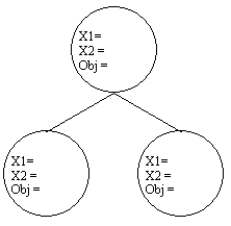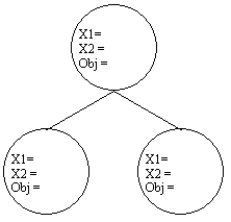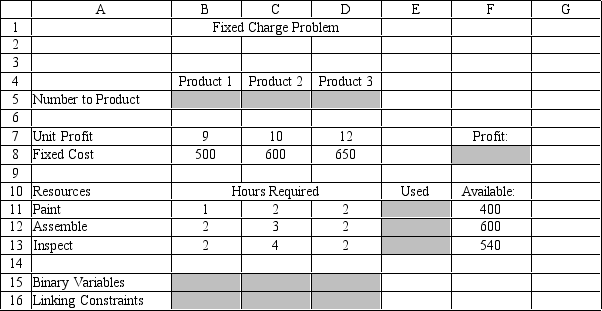Deck 6: Integer Linear Programming
Question
Question
Question
Question
Question
Question
Question
Question
Question
Question
Question
Question
Question
Question
Question
Question
Question
Question
Question
Question
Question
Question
Question
Question
Question
Question
Question
Question
Question
Question
Question
Question
Question
Question
Question
Question
Question
Question
Question
Question
Question
Question
Question
Question
Question
Question
Question
Question
Question
Question
Question
Question
Question
Question
Question
Question
Question
Question
Question
Question
Question
Question
Question
Question
Question
Question
Question
Question
Question
Question
Question
Question

Unlock Deck
Sign up to unlock the cards in this deck!
Unlock Deck
Unlock Deck
1/72
Play
Full screen (f)
Deck 6: Integer Linear Programming
1
A company wants to select 1 project from a set of 4 possible projects. Which of the following constraints ensures that only 1 will be selected?
A) X1 + X2 + X3 + X4 = 1
B) X1 + X2 + X3 + X4 1
C) X1 + X2 + X3 + X4 1
D) X1 + X2 + X3 + X4 0
A) X1 + X2 + X3 + X4 = 1
B) X1 + X2 + X3 + X4 1
C) X1 + X2 + X3 + X4 1
D) X1 + X2 + X3 + X4 0
X1 + X2 + X3 + X4 = 1
2
How is the integer tolerance factor set in the Risk Solver Platform (RSP)?
A) By adding a constraint for the decision variables who's RHS is the desired suboptimality level.
B) By choosing the optimal option in the RSP Options dialog box.
C) By choosing the 100% Precision field in the RSP Options dialog box.
D) By entering the desired tolerance factor value in the Integer Tolerance field of RSP.
A) By adding a constraint for the decision variables who's RHS is the desired suboptimality level.
B) By choosing the optimal option in the RSP Options dialog box.
C) By choosing the 100% Precision field in the RSP Options dialog box.
D) By entering the desired tolerance factor value in the Integer Tolerance field of RSP.
D
3
What does the Risk Solver Platform (RSP) default integer tolerance factor of 0 accomplish?
A) Stops B & B after 100% of all solutions are examined.
B) Stops B & B when any feasible ILP solution is 0% from the current ILP solution.
C) Stops B & B when the true optimal integer solution has been found.
D) Stops B & B when no more than 0% of the changing cells have integer values.
A) Stops B & B after 100% of all solutions are examined.
B) Stops B & B when any feasible ILP solution is 0% from the current ILP solution.
C) Stops B & B when the true optimal integer solution has been found.
D) Stops B & B when no more than 0% of the changing cells have integer values.
C
4
How is an LP problem changed into an ILP problem?
A) by adding constraints that the decision variables be non-negative.
B) by adding integrality conditions.
C) by adding discontinuity constraints.
D) by making the RHS values integer.
A) by adding constraints that the decision variables be non-negative.
B) by adding integrality conditions.
C) by adding discontinuity constraints.
D) by making the RHS values integer.

Unlock Deck
Unlock for access to all 72 flashcards in this deck.
Unlock Deck
k this deck
5
Which of the following are potential pitfalls of using a non-zero integer tolerance factor in the Risk Solver Platform (RSP)?
A) No assurance the returned solution is optimal.
B) No assurance the returned solution is integer.
C) The true optimal solution may be worse than the returned solution.
D) There are no pitfalls to consider since the Solver will obtain solutions quicker.
A) No assurance the returned solution is optimal.
B) No assurance the returned solution is integer.
C) The true optimal solution may be worse than the returned solution.
D) There are no pitfalls to consider since the Solver will obtain solutions quicker.

Unlock Deck
Unlock for access to all 72 flashcards in this deck.
Unlock Deck
k this deck
6
Which of the following is not a benefit of using binary variables?
A) With only 2 values, Solver can work faster.
B) Binary variables are useful in selection problems.
C) Binary variables can replace some IF() conditions.
D) Binary variables can enforce logical conditions.
A) With only 2 values, Solver can work faster.
B) Binary variables are useful in selection problems.
C) Binary variables can replace some IF() conditions.
D) Binary variables can enforce logical conditions.

Unlock Deck
Unlock for access to all 72 flashcards in this deck.
Unlock Deck
k this deck
7
The objective function value for the ILP problem can never
A) be as good as the optimal solution to its LP relaxation.
B) be as poor as the optimal solution to its LP relaxation.
C) be worse than the optimal solution to its LP relaxation.
D) be better than the optimal solution to its LP relaxation.
A) be as good as the optimal solution to its LP relaxation.
B) be as poor as the optimal solution to its LP relaxation.
C) be worse than the optimal solution to its LP relaxation.
D) be better than the optimal solution to its LP relaxation.

Unlock Deck
Unlock for access to all 72 flashcards in this deck.
Unlock Deck
k this deck
8
In the B & B algorithm, B & B stands for
A) Brooks and Baker
B) Best Bound
C) Best Branch
D) Branch and Bound
A) Brooks and Baker
B) Best Bound
C) Best Branch
D) Branch and Bound

Unlock Deck
Unlock for access to all 72 flashcards in this deck.
Unlock Deck
k this deck
9
Consider the constraint X3 + X4 + X5 + X6 + X7 27
Representing Air Express' Monday minimum worker requirement. Why was a " " used versus an "="?
A) The " " is needed to accommodate workers held over from Sunday.
B) Solver only accepts " " constraints.
C) The " " is less restrictive.
D) The "=" will always produce an infeasible constraint.
Representing Air Express' Monday minimum worker requirement. Why was a " " used versus an "="?
A) The " " is needed to accommodate workers held over from Sunday.
B) Solver only accepts " " constraints.
C) The " " is less restrictive.
D) The "=" will always produce an infeasible constraint.

Unlock Deck
Unlock for access to all 72 flashcards in this deck.
Unlock Deck
k this deck
10
A company wants to select no more than 2 projects from a set of 4 possible projects. Which of the following constraints ensures that no more than 2 will be selected?
A) X1 + X2 + X3 + X4 = 2
B) X1 + X2 + X3 + X4 2
C) X1 + X2 + X3 + X4 2
D) X1 + X2 + X3 + X4 0
A) X1 + X2 + X3 + X4 = 2
B) X1 + X2 + X3 + X4 2
C) X1 + X2 + X3 + X4 2
D) X1 + X2 + X3 + X4 0

Unlock Deck
Unlock for access to all 72 flashcards in this deck.
Unlock Deck
k this deck
11
How are binary variables specified in the Risk Solver Platform (RSP)?
A) By replacing RHS values in constraints with 0 or 1.
B) By specifying changing cells as INTEGER and as non-negative.
C) By specifying changing cells as BINARY in the Variable Type/Bound area of RSP.
D) By selecting Assume Binary Model in the RSP Options dialog box.
A) By replacing RHS values in constraints with 0 or 1.
B) By specifying changing cells as INTEGER and as non-negative.
C) By specifying changing cells as BINARY in the Variable Type/Bound area of RSP.
D) By selecting Assume Binary Model in the RSP Options dialog box.

Unlock Deck
Unlock for access to all 72 flashcards in this deck.
Unlock Deck
k this deck
12
How are general integrality requirements indicated in the Excel Risk Solver Platform (RSP)?
A) Specifying the INT option for the appropriate changing cells.
B) Specifying the INT option for the constraint rows.
C) Adding additional RHS values to constraints.
D) Choosing the BIN setting in the Value field in the Solver Parameters dialog box.
A) Specifying the INT option for the appropriate changing cells.
B) Specifying the INT option for the constraint rows.
C) Adding additional RHS values to constraints.
D) Choosing the BIN setting in the Value field in the Solver Parameters dialog box.

Unlock Deck
Unlock for access to all 72 flashcards in this deck.
Unlock Deck
k this deck
13
An ILP problem has 5 binary decision variables. How many possible integer solutions are there to this problem?
A) 5
B) 10
C) 25
D) 32
A) 5
B) 10
C) 25
D) 32

Unlock Deck
Unlock for access to all 72 flashcards in this deck.
Unlock Deck
k this deck
14
For minimization problems, the optimal objective function value to the LP relaxation provides what for the optimal objective function value of the ILP problem?
A) An upper bound.
B) A lower bound.
C) An alternative optimal solution.
D) An additional constraint for the ILP problem.
A) An upper bound.
B) A lower bound.
C) An alternative optimal solution.
D) An additional constraint for the ILP problem.

Unlock Deck
Unlock for access to all 72 flashcards in this deck.
Unlock Deck
k this deck
15
Variables, which are not required to assume strictly integer values are referred to as
A) strictly non-integer.
B) continuous.
C) discrete.
D) infinite.
A) strictly non-integer.
B) continuous.
C) discrete.
D) infinite.

Unlock Deck
Unlock for access to all 72 flashcards in this deck.
Unlock Deck
k this deck
16
For maximization problems, the optimal objective function value to the LP relaxation provides what for the optimal objective function value of the ILP problem?
A) An upper bound.
B) A lower bound.
C) An alternative optimal solution.
D) An additional constraint for the ILP problem.
A) An upper bound.
B) A lower bound.
C) An alternative optimal solution.
D) An additional constraint for the ILP problem.

Unlock Deck
Unlock for access to all 72 flashcards in this deck.
Unlock Deck
k this deck
17
An integrality condition indicates that some (or all) of the
A) RHS values for constraints must be integer
B) objective function coefficients must be integer
C) constraint coefficients must be integer
D) decision variables must be integer
A) RHS values for constraints must be integer
B) objective function coefficients must be integer
C) constraint coefficients must be integer
D) decision variables must be integer

Unlock Deck
Unlock for access to all 72 flashcards in this deck.
Unlock Deck
k this deck
18
The LP relaxation of an ILP problem
A) always encompasses all the feasible integer solutions to the original ILP problem.
B) encompasses at least 90% of the feasible integer solutions to the original ILP problem.
C) encompasses different set of feasible integer solutions to the original ILP problem.
D) will not contain the feasible integer solutions to the original ILP problem.
A) always encompasses all the feasible integer solutions to the original ILP problem.
B) encompasses at least 90% of the feasible integer solutions to the original ILP problem.
C) encompasses different set of feasible integer solutions to the original ILP problem.
D) will not contain the feasible integer solutions to the original ILP problem.

Unlock Deck
Unlock for access to all 72 flashcards in this deck.
Unlock Deck
k this deck
19
One approach to solving integer programming problems is to ignore the integrality conditions and solve the problem with continuous decision variables. This is referred to as
A) quickest solution method.
B) LP satisficing.
C) LP relaxation.
D) LP approximation.
A) quickest solution method.
B) LP satisficing.
C) LP relaxation.
D) LP approximation.

Unlock Deck
Unlock for access to all 72 flashcards in this deck.
Unlock Deck
k this deck
20
The B & B algorithm solves ILP problems
A) by solving for each variable separately.
B) by solving for the integer variables first.
C) by solving a series of LP problems.
D) by solving smaller ILP problems.
A) by solving for each variable separately.
B) by solving for the integer variables first.
C) by solving a series of LP problems.
D) by solving smaller ILP problems.

Unlock Deck
Unlock for access to all 72 flashcards in this deck.
Unlock Deck
k this deck
21
A production company wants to ensure that if Product 1 is produced, production of Product 1 not exceed production of Product 2. Which of the following constraints enforce this condition?
A) X1 M2Y2
B) X1 M2X2
C) X1 M1Y1, X1 Y1X2
D) X1 X2
A) X1 M2Y2
B) X1 M2X2
C) X1 M1Y1, X1 Y1X2
D) X1 X2

Unlock Deck
Unlock for access to all 72 flashcards in this deck.
Unlock Deck
k this deck
22
Any integer variable in an ILP that assumes a fractional value in the optimal solution to the relaxed LP problem can be designated
A) a diverging variable.
B) a branching variable.
C) a bifurcating variable.
D) a splitting variable.
A) a diverging variable.
B) a branching variable.
C) a bifurcating variable.
D) a splitting variable.

Unlock Deck
Unlock for access to all 72 flashcards in this deck.
Unlock Deck
k this deck
23
A company is developing its weekly production plan. The company produces two products, A and B, which are processed in two departments. Setting up each batch of A requires $60 of labor while setting up a batch of B costs $80. Each unit of A generates a profit of $17 while a unit of B earns a profit of $21. The company can sell all the units it produces. The data for the problem are summarized below.
The decision variables are defined as
Xi = the amount of product i produced
Yi = 1 if Xi > 0 and 0 if Xi = 0
What is the appropriate value for M1 in the linking constraint for product A?
A) 2
B) 3
C) 16
D) 12
The decision variables are defined as
Xi = the amount of product i produced
Yi = 1 if Xi > 0 and 0 if Xi = 0
What is the appropriate value for M1 in the linking constraint for product A?
A) 2
B) 3
C) 16
D) 12

Unlock Deck
Unlock for access to all 72 flashcards in this deck.
Unlock Deck
k this deck
24
The branch-and-bound algorithm starts by
A) relaxing all the integrality conditions in an ILP and solving the resulting LP problem.
B) relaxing all the RHS values in an ILP and solving the resulting LP problem.
C) solving two LP problems in which X1 is set at 0 and 1 respectively.
D) determining the most likely RHS values and solving for them.
A) relaxing all the integrality conditions in an ILP and solving the resulting LP problem.
B) relaxing all the RHS values in an ILP and solving the resulting LP problem.
C) solving two LP problems in which X1 is set at 0 and 1 respectively.
D) determining the most likely RHS values and solving for them.

Unlock Deck
Unlock for access to all 72 flashcards in this deck.
Unlock Deck
k this deck
25
A company will be able to obtain a quantity discount on component parts for its three products, X1, X2 and X3 if it produces beyond certain limits. To get the X1 discount it must produce more than 50 X1's. It must produce more than 60 X2's for the X2 discount and 70 X3's for the X3 discount. Which of the following pair of constraints enforces the quantity discount relationship on X3?
A) X31 M3Y3, X32 50Y3
B) X31 M3Y3, X31 50
C) X32 (1/50)X31, X31 50
D) X32 M3Y3, X31 50Y3
A) X31 M3Y3, X32 50Y3
B) X31 M3Y3, X31 50
C) X32 (1/50)X31, X31 50
D) X32 M3Y3, X31 50Y3

Unlock Deck
Unlock for access to all 72 flashcards in this deck.
Unlock Deck
k this deck
26
The setup cost incurred in preparing a machine to produce a batch of product is an example of a
A) fixed charge.
B) random charge.
C) sunk cost.
D) variable cost.
A) fixed charge.
B) random charge.
C) sunk cost.
D) variable cost.

Unlock Deck
Unlock for access to all 72 flashcards in this deck.
Unlock Deck
k this deck
27
A company is planning next month's production. It has to pay a setup cost to produce a batch of X4's so if it does produce a batch it wants to produce at least 100 units. Which of the following pairs of constraints show the relationship(s) between the setup variable Y4 and the production quantity variable X4?
A) X4 M4Y4, X4 100
B) X4 M4Y4, X4 = 100 Y4
C) X4 M4Y4, X4 100 Y4
D) X4 M4Y4, X4 100 Y4
A) X4 M4Y4, X4 100
B) X4 M4Y4, X4 = 100 Y4
C) X4 M4Y4, X4 100 Y4
D) X4 M4Y4, X4 100 Y4

Unlock Deck
Unlock for access to all 72 flashcards in this deck.
Unlock Deck
k this deck
28
If a company produces Product 1, then it must produce at least 150 units of Product 1. Which of the following constraints enforces this condition?
A) X1 150Y1
B) X1 -150Y1 0
C) X1Y1 150
D) X1 F 150 + Y1
A) X1 150Y1
B) X1 -150Y1 0
C) X1Y1 150
D) X1 F 150 + Y1

Unlock Deck
Unlock for access to all 72 flashcards in this deck.
Unlock Deck
k this deck
29
The optimal relaxed solution for an ILP has X1 = 3.6 and X2 = 2.9. If we branch on X1, what constraints must be added to the two resulting LP problems?
A) X1 3, X1 4
B) X1 = 4
C) 3 X1, X1 4
D) X1 3, X1 4
A) X1 3, X1 4
B) X1 = 4
C) 3 X1, X1 4
D) X1 3, X1 4

Unlock Deck
Unlock for access to all 72 flashcards in this deck.
Unlock Deck
k this deck
30
A company will be able to obtain a quantity discount on component parts for its three products, X1, X2 and X3 if it produces beyond certain limits. To get the X1 discount it must produce more than 50 X1's. It must produce more than 60 X2's for the X2 discount and 70 X3's for the X3 discount. How many binary variables are required in the formulation of this problem?
A) 3
B) 6
C) 9
D) 12
A) 3
B) 6
C) 9
D) 12

Unlock Deck
Unlock for access to all 72 flashcards in this deck.
Unlock Deck
k this deck
31
A company is developing its weekly production plan. The company produces two products, A and B, which are processed in two departments. Setting up each batch of A requires $60 of labor while setting up a batch of B costs $80. Each unit of A generates a profit of $17 while a unit of B earns a profit of $21. The company can sell all the units it produces. The data for the problem are summarized below.
The decision variables are defined as
Xi = the amount of product i produced
Yi = 1 if Xi > 0 and 0 if Xi = 0
Which of the following constraints creates the link between setting up to produce A's and making some A's for this problem?
A) X1 16Y1
B) X1 -Y1 = 0
C) X1- 18Y1 > 0
D) = if(X1 > 0, Y1 = 1, Y1 = 0)
The decision variables are defined as
Xi = the amount of product i produced
Yi = 1 if Xi > 0 and 0 if Xi = 0
Which of the following constraints creates the link between setting up to produce A's and making some A's for this problem?
A) X1 16Y1
B) X1 -Y1 = 0
C) X1- 18Y1 > 0
D) = if(X1 > 0, Y1 = 1, Y1 = 0)

Unlock Deck
Unlock for access to all 72 flashcards in this deck.
Unlock Deck
k this deck
32
If a company selects either of Project 1 or Project 2 (or both), then either Project 3 or Project 4 (or both) must also be selected. Which of the following constraints enforce this condition?
A) X1 + X2 2(X3 + X4)
B) X1 + X2 X3 + X4
C) X1 -X3 = X2 - X4
D) X1 + X2 + X3 + X4 2
A) X1 + X2 2(X3 + X4)
B) X1 + X2 X3 + X4
C) X1 -X3 = X2 - X4
D) X1 + X2 + X3 + X4 2

Unlock Deck
Unlock for access to all 72 flashcards in this deck.
Unlock Deck
k this deck
33
A wedding caterer has several wine shops from which it can order champagne. The caterer needs 100 bottles of champagne on a particular weekend for 2 weddings. The first supplier can supply either 40 bottles or 90 bottles. The relevant decision variable is defined as
X1 = the number of bottles supplied by supplier 1
Which set of constraints reflects the fact that supplier 1 can supply only 40 or 90 bottles?
A) X1 40 Y11, X1 90(1 - Y11)
B) X1 = 40Y11 + 90Y12, Y11 + Y12 1
C) X1 = 40Y1 + 90(1 - Y1), Y1 = 0 OR 1
D) X1 = 40Y11 + 90Y12, Y11 + Y12 = 1
X1 = the number of bottles supplied by supplier 1
Which set of constraints reflects the fact that supplier 1 can supply only 40 or 90 bottles?
A) X1 40 Y11, X1 90(1 - Y11)
B) X1 = 40Y11 + 90Y12, Y11 + Y12 1
C) X1 = 40Y1 + 90(1 - Y1), Y1 = 0 OR 1
D) X1 = 40Y11 + 90Y12, Y11 + Y12 = 1

Unlock Deck
Unlock for access to all 72 flashcards in this deck.
Unlock Deck
k this deck
34
A company is developing its weekly production plan. The company produces two products, A and B, which are processed in two departments. Setting up each batch of A requires $60 of labor while setting up a batch of B costs $80. Each unit of A generates a profit of $17 while a unit of B earns a profit of $21. The company can sell all the units it produces. The data for the problem are summarized below.
What is the appropriate formula to use in cell E8 of the following Excel implementation of the ILP model for this problem?

A) =SUMPRODUCT(B5:C5,B7:C7) - SUMPRODUCT(B8:C8,B14:C14)
B) =SUMPRODUCT(B8:C8,B14:C14) - SUMPRODUCT(B5:C5,B7:C7)
C) =SUMPRODUCT(B5:C5,B7:C7) - B8:C8
D) =SUMPRODUCT(B5:C5,B7:C7) - SUMPRODUCT(B8:C8,B15:C15)
What is the appropriate formula to use in cell E8 of the following Excel implementation of the ILP model for this problem?

A) =SUMPRODUCT(B5:C5,B7:C7) - SUMPRODUCT(B8:C8,B14:C14)
B) =SUMPRODUCT(B8:C8,B14:C14) - SUMPRODUCT(B5:C5,B7:C7)
C) =SUMPRODUCT(B5:C5,B7:C7) - B8:C8
D) =SUMPRODUCT(B5:C5,B7:C7) - SUMPRODUCT(B8:C8,B15:C15)

Unlock Deck
Unlock for access to all 72 flashcards in this deck.
Unlock Deck
k this deck
35
A company is developing its weekly production plan. The company produces two products, A and B, which are processed in two departments. Setting up each batch of A requires $60 of labor while setting up a batch of B costs $80. Each unit of A generates a profit of $17 while a unit of B earns a profit of $21. The company can sell all the units it produces. The data for the problem are summarized below.
What is the appropriate formula to use in cell B15 of the following Excel implementation of the ILP model for this problem?

A) =B5- MIN($E$11/B11, $E$11/C11)*B14
B) =B5 -MIN($E$11/B11, $E$12/B12)
C) =B5- $E$12/B12*B14
D) =B5 - MIN($E$11/B11, $E$12/B12)*B14
What is the appropriate formula to use in cell B15 of the following Excel implementation of the ILP model for this problem?

A) =B5- MIN($E$11/B11, $E$11/C11)*B14
B) =B5 -MIN($E$11/B11, $E$12/B12)
C) =B5- $E$12/B12*B14
D) =B5 - MIN($E$11/B11, $E$12/B12)*B14

Unlock Deck
Unlock for access to all 72 flashcards in this deck.
Unlock Deck
k this deck
36
If a company selects Project 1 then it must also select either Project 2 or Project 3. Which of the following constraints enforces this condition?
A) X1- X2 - X3 0
B) X1 + (X2 - X3) 0
C) X1 + X2 + X3 2
D) X1 -X2 -X3 0
A) X1- X2 - X3 0
B) X1 + (X2 - X3) 0
C) X1 + X2 + X3 2
D) X1 -X2 -X3 0

Unlock Deck
Unlock for access to all 72 flashcards in this deck.
Unlock Deck
k this deck
37
A company must invest in project 1 in order to invest in project 2. Which of the following constraints ensures that project 1 will be chosen if project 2 is invested in?
A) X1 + X2 = 0
B) X1 + X2 = 1
C) X1 -X2 0
D) X1- X2 0
A) X1 + X2 = 0
B) X1 + X2 = 1
C) X1 -X2 0
D) X1- X2 0

Unlock Deck
Unlock for access to all 72 flashcards in this deck.
Unlock Deck
k this deck
38
A manufacturing company has costs associated with production preparation and with per unit production. The per unit production costs are referred to as
A) decision variables.
B) production cost constraint coefficients.
C) variable costs.
D) marginal costs.
A) decision variables.
B) production cost constraint coefficients.
C) variable costs.
D) marginal costs.

Unlock Deck
Unlock for access to all 72 flashcards in this deck.
Unlock Deck
k this deck
39
A company is developing its weekly production plan. The company produces two products, A and B, which are processed in two departments. Setting up each batch of A requires $60 of labor while setting up a batch of B costs $80. Each unit of A generates a profit of $17 while a unit of B earns a profit of $21. The company can sell all the units it produces. The data for the problem are summarized below.
The decision variables are defined as
Xi = the amount of product i produced
Yi = 1 if Xi > 0 and 0 if Xi = 0
What is the objective function for this problem?
A) MAX: 17 X1 + 21 X2
B) MAX: 17 X1 + 21 X2 - 60 Y1 - 80 Y2
C) MIN: 17 X1 + 21 X2 -60 Y1 - 80 Y2
D) MIN: 60 Y1 + 80 Y2
The decision variables are defined as
Xi = the amount of product i produced
Yi = 1 if Xi > 0 and 0 if Xi = 0
What is the objective function for this problem?
A) MAX: 17 X1 + 21 X2
B) MAX: 17 X1 + 21 X2 - 60 Y1 - 80 Y2
C) MIN: 17 X1 + 21 X2 -60 Y1 - 80 Y2
D) MIN: 60 Y1 + 80 Y2

Unlock Deck
Unlock for access to all 72 flashcards in this deck.
Unlock Deck
k this deck
40
A company will be able to obtain a quantity discount on component parts for its three products, X1, X2 and X3 if it produces beyond certain limits. To get the X1 discount it must produce more than 50 X1's. It must produce more than 60 X2's for the X2 discount and 70 X3's for the X3 discount. How many decision variables are required in the formulation of this problem?
A) 3
B) 6
C) 9
D) 12
A) 3
B) 6
C) 9
D) 12

Unlock Deck
Unlock for access to all 72 flashcards in this deck.
Unlock Deck
k this deck
41
A company wants to build a new factory in either Atlanta or Columbia. It is also considering building a warehouse in whichever city is selected for the new factory. The following table shows the net present value (NPV) and cost of each facility. The company wants to maximize the net present value of its facilities, but it only has $15 million to invest.
Formulate the ILP for this problem.

Formulate the ILP for this problem.


Unlock Deck
Unlock for access to all 72 flashcards in this deck.
Unlock Deck
k this deck
42
A sub-problem in a B & B is solved and found infeasible. Should the B & B algorithm continue further analysis on this candidate problem?
A) Yes, a feasible solution may be found when additional constraints are added.
B) Yes, removing a constraint in further analysis may restore feasibility.
C) No, adding more constraints will not restore problem feasibility.
D) No, the result cannot occur so re-examine the formulation and start over.
A) Yes, a feasible solution may be found when additional constraints are added.
B) Yes, removing a constraint in further analysis may restore feasibility.
C) No, adding more constraints will not restore problem feasibility.
D) No, the result cannot occur so re-examine the formulation and start over.

Unlock Deck
Unlock for access to all 72 flashcards in this deck.
Unlock Deck
k this deck
43
An investor has $500,000 to invest and wants to maximize the money they will receive at the end of one year. They can invest in condos, apartments and houses. The profit after one year, the cost and the number of units available are shown below.
 Based on this ILP formulation of the problem and the indicated optimal integer solution values what values should go in cells B5:F12 of the following Excel spreadsheet?
Based on this ILP formulation of the problem and the indicated optimal integer solution values what values should go in cells B5:F12 of the following Excel spreadsheet?


 Based on this ILP formulation of the problem and the indicated optimal integer solution values what values should go in cells B5:F12 of the following Excel spreadsheet?
Based on this ILP formulation of the problem and the indicated optimal integer solution values what values should go in cells B5:F12 of the following Excel spreadsheet?


Unlock Deck
Unlock for access to all 72 flashcards in this deck.
Unlock Deck
k this deck
44
A small town wants to build some new recreational facilities. The proposed facilities include a swimming pool, recreation center, basketball court and baseball field. The town council wants to provide the facilities which will be used by the most people, but faces budget and land limitations. The town has $400,000 and 14 acres of land. The pool requires locker facilities which would be in the recreation center, so if the swimming pool is built the recreation center must also be built. Also the council has only enough flat land to build the basketball court or the baseball field. The daily usage and cost of the facilities (in $1,000) are shown below.
 Based on this ILP formulation of the problem and the indicated optimal solution what values should go in cells B5:G12 of the following Excel spreadsheet?
Based on this ILP formulation of the problem and the indicated optimal solution what values should go in cells B5:G12 of the following Excel spreadsheet?


 Based on this ILP formulation of the problem and the indicated optimal solution what values should go in cells B5:G12 of the following Excel spreadsheet?
Based on this ILP formulation of the problem and the indicated optimal solution what values should go in cells B5:G12 of the following Excel spreadsheet?


Unlock Deck
Unlock for access to all 72 flashcards in this deck.
Unlock Deck
k this deck
45
A company wants to build a new factory in either Atlanta or Columbia. It is also considering building a warehouse in whichever city is selected for the new factory. The following table shows the net present value (NPV) and cost of each facility. The company wants to maximize the net present value of its facilities, but it only has $15 million to invest.
 Based on this ILP formulation of the problem and the indicated optimal solution what values should go in cells B6:G14 of the following Excel spreadsheet?
Based on this ILP formulation of the problem and the indicated optimal solution what values should go in cells B6:G14 of the following Excel spreadsheet?


 Based on this ILP formulation of the problem and the indicated optimal solution what values should go in cells B6:G14 of the following Excel spreadsheet?
Based on this ILP formulation of the problem and the indicated optimal solution what values should go in cells B6:G14 of the following Excel spreadsheet?


Unlock Deck
Unlock for access to all 72 flashcards in this deck.
Unlock Deck
k this deck
46
Exhibit 6.1
The following questions pertain to the problem, formulation, and spreadsheet implementation below.
A research director must pick a subset of research projects to fund over the next five years. He has five candidate projects, not all of which cover the entire five-year period. Although the director has limited funds in each of the next five years, he can carry over unspent research funds into the next year. Additionally, up to $30K can be carried out of the five-year planning period. The following table summarizes the projects and budget available to the research director.
 The following is the ILP formulation and a spreadsheet model for the problem.
The following is the ILP formulation and a spreadsheet model for the problem.


Refer to Exhibit 6.1. What values would you enter in the Risk Solver Platform (RSP) task pane for the above Excel spreadsheet?
Objective Cell:
Variables Cells:
Constraints Cells:
The following questions pertain to the problem, formulation, and spreadsheet implementation below.
A research director must pick a subset of research projects to fund over the next five years. He has five candidate projects, not all of which cover the entire five-year period. Although the director has limited funds in each of the next five years, he can carry over unspent research funds into the next year. Additionally, up to $30K can be carried out of the five-year planning period. The following table summarizes the projects and budget available to the research director.
 The following is the ILP formulation and a spreadsheet model for the problem.
The following is the ILP formulation and a spreadsheet model for the problem.

Refer to Exhibit 6.1. What values would you enter in the Risk Solver Platform (RSP) task pane for the above Excel spreadsheet?
Objective Cell:
Variables Cells:
Constraints Cells:

Unlock Deck
Unlock for access to all 72 flashcards in this deck.
Unlock Deck
k this deck
47
A city wants to locate 2 new fire fighting ladder trucks to maximize the number of tall buildings which they can cover within a 3 minute response time. The city is divided into 4 zones. The fire chief wants to locate no more than one of the trucks in either Zone 1 or Zone 2. The number of tall buildings in each zone and the travel time between zones is listed below.
Formulate the ILP for this problem.

Formulate the ILP for this problem.


Unlock Deck
Unlock for access to all 72 flashcards in this deck.
Unlock Deck
k this deck
48
A company wants to build a new factory in either Atlanta or Columbia. It is also considering building a warehouse in whichever city is selected for the new factory. The following table shows the net present value (NPV) and cost of each facility. The company wants to maximize the net present value of its facilities, but it only has $16 million to invest.
 Based on this ILP formulation of the problem what is the optimal solution to the problem?
Based on this ILP formulation of the problem what is the optimal solution to the problem?

 Based on this ILP formulation of the problem what is the optimal solution to the problem?
Based on this ILP formulation of the problem what is the optimal solution to the problem?

Unlock Deck
Unlock for access to all 72 flashcards in this deck.
Unlock Deck
k this deck
49
Exhibit 6.1
The following questions pertain to the problem, formulation, and spreadsheet implementation below.
A research director must pick a subset of research projects to fund over the next five years. He has five candidate projects, not all of which cover the entire five-year period. Although the director has limited funds in each of the next five years, he can carry over unspent research funds into the next year. Additionally, up to $30K can be carried out of the five-year planning period. The following table summarizes the projects and budget available to the research director.
 The following is the ILP formulation and a spreadsheet model for the problem.
The following is the ILP formulation and a spreadsheet model for the problem.


Refer to Exhibit 6.1. What formula should go in cell D15 of the above Excel spreadsheet?
The following questions pertain to the problem, formulation, and spreadsheet implementation below.
A research director must pick a subset of research projects to fund over the next five years. He has five candidate projects, not all of which cover the entire five-year period. Although the director has limited funds in each of the next five years, he can carry over unspent research funds into the next year. Additionally, up to $30K can be carried out of the five-year planning period. The following table summarizes the projects and budget available to the research director.
 The following is the ILP formulation and a spreadsheet model for the problem.
The following is the ILP formulation and a spreadsheet model for the problem.

Refer to Exhibit 6.1. What formula should go in cell D15 of the above Excel spreadsheet?

Unlock Deck
Unlock for access to all 72 flashcards in this deck.
Unlock Deck
k this deck
50
A city wants to locate 2 new fire fighting ladder trucks to maximize the number of tall buildings which they can cover within a 3 minute response time. The city is divided into 4 zones. The fire chief wants to locate no more than one of the trucks in either Zone 1 or Zone 2. The number of tall buildings in each zone and the travel time between zones is listed below.
 Based on this ILP formulation of the problem what values should go in cells B5:G24 of the following Excel spreadsheet?
Based on this ILP formulation of the problem what values should go in cells B5:G24 of the following Excel spreadsheet?
Let Xi = 1 if truck located in zone i, 0 otherwise



 Based on this ILP formulation of the problem what values should go in cells B5:G24 of the following Excel spreadsheet?
Based on this ILP formulation of the problem what values should go in cells B5:G24 of the following Excel spreadsheet?Let Xi = 1 if truck located in zone i, 0 otherwise




Unlock Deck
Unlock for access to all 72 flashcards in this deck.
Unlock Deck
k this deck
51
An investor has $500,000 to invest and wants to maximize the money they will receive at the end of one year. They can invest in condos, apartments and houses. The profit after one year, the cost and the number of units available are shown below.
Formulate the ILP for this problem.

Formulate the ILP for this problem.


Unlock Deck
Unlock for access to all 72 flashcards in this deck.
Unlock Deck
k this deck
52
A company has four projects, numbered 1 through 4. If any project is selected for implementation, each lower-numbered project must also be selected for implementation. Formulate the constraints to enforce these conditions.

Unlock Deck
Unlock for access to all 72 flashcards in this deck.
Unlock Deck
k this deck
53
An investor has $500,000 to invest and wants to maximize the money they will receive at the end of one year. They can invest in condos, apartments and houses. The profit after one year, the cost and the number of units available are shown below.
 Based on this ILP formulation of the problem what formulas should go in cells E5:E12 of the following Excel spreadsheet?
Based on this ILP formulation of the problem what formulas should go in cells E5:E12 of the following Excel spreadsheet?


 Based on this ILP formulation of the problem what formulas should go in cells E5:E12 of the following Excel spreadsheet?
Based on this ILP formulation of the problem what formulas should go in cells E5:E12 of the following Excel spreadsheet?


Unlock Deck
Unlock for access to all 72 flashcards in this deck.
Unlock Deck
k this deck
54
Exhibit 6.1
The following questions pertain to the problem, formulation, and spreadsheet implementation below.
A research director must pick a subset of research projects to fund over the next five years. He has five candidate projects, not all of which cover the entire five-year period. Although the director has limited funds in each of the next five years, he can carry over unspent research funds into the next year. Additionally, up to $30K can be carried out of the five-year planning period. The following table summarizes the projects and budget available to the research director.
 The following is the ILP formulation and a spreadsheet model for the problem.
The following is the ILP formulation and a spreadsheet model for the problem.


Refer to Exhibit 6.1. What formulas should go in cells D8:H8 and D11:H11 of the above Excel spreadsheet?
The following questions pertain to the problem, formulation, and spreadsheet implementation below.
A research director must pick a subset of research projects to fund over the next five years. He has five candidate projects, not all of which cover the entire five-year period. Although the director has limited funds in each of the next five years, he can carry over unspent research funds into the next year. Additionally, up to $30K can be carried out of the five-year planning period. The following table summarizes the projects and budget available to the research director.
 The following is the ILP formulation and a spreadsheet model for the problem.
The following is the ILP formulation and a spreadsheet model for the problem.

Refer to Exhibit 6.1. What formulas should go in cells D8:H8 and D11:H11 of the above Excel spreadsheet?

Unlock Deck
Unlock for access to all 72 flashcards in this deck.
Unlock Deck
k this deck
55
A company wants to build a new factory in either Atlanta or Columbia. It is also considering building a warehouse in whichever city is selected for the new factory. The following table shows the net present value (NPV) and cost of each facility. The company wants to maximize the net present value of its facilities, but it only has $16 million to invest.
 Based on this ILP formulation of the problem and the indicated optimal solution what formulas should go in cells F6:F14 of the following Excel spreadsheet?
Based on this ILP formulation of the problem and the indicated optimal solution what formulas should go in cells F6:F14 of the following Excel spreadsheet?


 Based on this ILP formulation of the problem and the indicated optimal solution what formulas should go in cells F6:F14 of the following Excel spreadsheet?
Based on this ILP formulation of the problem and the indicated optimal solution what formulas should go in cells F6:F14 of the following Excel spreadsheet?


Unlock Deck
Unlock for access to all 72 flashcards in this deck.
Unlock Deck
k this deck
56
A research director must pick a subset of research projects to fund over the next five years. He has five candidate projects, not all of which cover the entire five-year period. Although the director has limited funds in each of the next five years, he can carry over unspent research funds into the next year. Additionally, up to $30K can be carried out of the five-year planning period. The following table summarizes the projects and budget available to the research director.
 Define the ILP formulation for this capital budgeting problem.
Define the ILP formulation for this capital budgeting problem.
 Define the ILP formulation for this capital budgeting problem.
Define the ILP formulation for this capital budgeting problem.
Unlock Deck
Unlock for access to all 72 flashcards in this deck.
Unlock Deck
k this deck
57
A city wants to locate 2 new fire fighting ladder trucks to maximize the number of tall buildings which they can cover within a 3 minute response time. The city is divided into 4 zones. The fire chief wants to locate no more than one of the trucks in either Zone 1 or Zone 2. The number of tall buildings in each zone and the travel time between zones is listed below.
 Based on this ILP formulation of the problem what formulas should go in cells B13:B16, B20:E20, F20, and F23:F24 of the following Excel spreadsheet?
Based on this ILP formulation of the problem what formulas should go in cells B13:B16, B20:E20, F20, and F23:F24 of the following Excel spreadsheet?
Let Xi = 1 if truck located in zone i, 0 otherwise



 Based on this ILP formulation of the problem what formulas should go in cells B13:B16, B20:E20, F20, and F23:F24 of the following Excel spreadsheet?
Based on this ILP formulation of the problem what formulas should go in cells B13:B16, B20:E20, F20, and F23:F24 of the following Excel spreadsheet?Let Xi = 1 if truck located in zone i, 0 otherwise




Unlock Deck
Unlock for access to all 72 flashcards in this deck.
Unlock Deck
k this deck
58
A small town wants to build some new recreational facilities. The proposed facilities include a swimming pool, recreation center, basketball court and baseball field. The town council wants to provide the facilities which will be used by the most people, but faces budget and land limitations. The town has $400,000 and 14 acres of land. The pool requires locker facilities which would be in the recreation center, so if the swimming pool is built the recreation center must also be built. Also the council has only enough flat land to build the basketball court or the baseball field. The daily usage and cost of the facilities (in $1,000) are shown below.
Formulate the ILP for this problem.

Formulate the ILP for this problem.


Unlock Deck
Unlock for access to all 72 flashcards in this deck.
Unlock Deck
k this deck
59
A small town wants to build some new recreational facilities. The proposed facilities include a swimming pool, recreation center, basketball court and baseball field. The town council wants to provide the facilities which will be used by the most people, but faces budget and land limitations. The town has $400,000 and 14 acres of land. The pool requires locker facilities which would be in the recreation center, so if the swimming pool is built the recreation center must also be built. Also the council has only enough flat land to build the basketball court or the baseball field. The daily usage and cost of the facilities (in $1,000) are shown below.
 Based on this ILP formulation of the problem what formulas should go in cells F5:F12 of the following Excel spreadsheet?
Based on this ILP formulation of the problem what formulas should go in cells F5:F12 of the following Excel spreadsheet?


 Based on this ILP formulation of the problem what formulas should go in cells F5:F12 of the following Excel spreadsheet?
Based on this ILP formulation of the problem what formulas should go in cells F5:F12 of the following Excel spreadsheet?


Unlock Deck
Unlock for access to all 72 flashcards in this deck.
Unlock Deck
k this deck
60
A company needs to hire workers to cover a 7 day work week. Employees work 5 consecutive days with 2 days off. The demand for workers by day of the week and the wages per shift are:
 Formulate the ILP for this problem.
Formulate the ILP for this problem.
 Formulate the ILP for this problem.
Formulate the ILP for this problem.
Unlock Deck
Unlock for access to all 72 flashcards in this deck.
Unlock Deck
k this deck
61
The following ILP is being solved by the branch and bound method. You have been given the initial relaxed IP solution. Complete the entries for the 3 nodes and label the arcs when you branch on X1.
 Initial solution
Initial solution
X1 = 4.6X2 = 1.6
Obj = 233.9

 Initial solution
Initial solutionX1 = 4.6X2 = 1.6
Obj = 233.9


Unlock Deck
Unlock for access to all 72 flashcards in this deck.
Unlock Deck
k this deck
62
A company produces three products which must be painted, assembled, and inspected. The machinery must be cleaned and adjusted before each batch is produced. They want to maximize their profits for the amount of operating time they have. The unit profit and setup cost per batch are:
 The operation time per unit and total operating hours available are:
The operation time per unit and total operating hours available are:
 Formulate the ILP for this problem.
Formulate the ILP for this problem.
 The operation time per unit and total operating hours available are:
The operation time per unit and total operating hours available are: Formulate the ILP for this problem.
Formulate the ILP for this problem.
Unlock Deck
Unlock for access to all 72 flashcards in this deck.
Unlock Deck
k this deck
63
A cellular phone company wants to locate two new communications towers to cover 4 regions. The company wants to minimize the cost of installing the two towers. The regions that can be covered by each tower site are indicated by a 1 in the following table:

 Based on this ILP formulation of the problem and the solution (X1, X2, X3, X4) = (1, 1, 0, 0) what values should go in cells B6:G14 of the following Excel spreadsheet?
Based on this ILP formulation of the problem and the solution (X1, X2, X3, X4) = (1, 1, 0, 0) what values should go in cells B6:G14 of the following Excel spreadsheet?


 Based on this ILP formulation of the problem and the solution (X1, X2, X3, X4) = (1, 1, 0, 0) what values should go in cells B6:G14 of the following Excel spreadsheet?
Based on this ILP formulation of the problem and the solution (X1, X2, X3, X4) = (1, 1, 0, 0) what values should go in cells B6:G14 of the following Excel spreadsheet?

Unlock Deck
Unlock for access to all 72 flashcards in this deck.
Unlock Deck
k this deck
64
The following ILP is being solved by the branch and bound method. You have been given the initial relaxed IP solution. Complete the entries for the 3 nodes and label the arcs when you branch on X2.
 Initial solution
Initial solution
X1 = 5.0
X2 = 7.5
Obj = 550

 Initial solution
Initial solutionX1 = 5.0
X2 = 7.5
Obj = 550


Unlock Deck
Unlock for access to all 72 flashcards in this deck.
Unlock Deck
k this deck
65
Exhibit 6.2
The following questions pertain to the problem, formulation, and spreadsheet implementation below.
A certain military deployment requires supplies delivered to four locations. These deliveries come from one of three ports. Logistics planners wish to deliver the supplies in an efficient manner, in this case by minimizing total ton-miles. The port-destination data, along with destination demand is provided in the following table.
 The ports are supplied by one of two supply ships. These ships travel to a particular port where their supplies are off-loaded and shipped to the requesting destinations. Ship S1 carries 1200 tones of supplies while Ship S2 carries 1120 tons of supplies. These ships can only go to a single port and each port can only accommodate one ship. Assume the costs for a ship to travel to a port are not part of the objective function.
The ports are supplied by one of two supply ships. These ships travel to a particular port where their supplies are off-loaded and shipped to the requesting destinations. Ship S1 carries 1200 tones of supplies while Ship S2 carries 1120 tons of supplies. These ships can only go to a single port and each port can only accommodate one ship. Assume the costs for a ship to travel to a port are not part of the objective function.
The following is the ILP formulation and a spreadsheet model for the problem.


Refer to Exhibit 6.2. What formula would go into cells B11:E11 and cells F8:F10?
The following questions pertain to the problem, formulation, and spreadsheet implementation below.
A certain military deployment requires supplies delivered to four locations. These deliveries come from one of three ports. Logistics planners wish to deliver the supplies in an efficient manner, in this case by minimizing total ton-miles. The port-destination data, along with destination demand is provided in the following table.
 The ports are supplied by one of two supply ships. These ships travel to a particular port where their supplies are off-loaded and shipped to the requesting destinations. Ship S1 carries 1200 tones of supplies while Ship S2 carries 1120 tons of supplies. These ships can only go to a single port and each port can only accommodate one ship. Assume the costs for a ship to travel to a port are not part of the objective function.
The ports are supplied by one of two supply ships. These ships travel to a particular port where their supplies are off-loaded and shipped to the requesting destinations. Ship S1 carries 1200 tones of supplies while Ship S2 carries 1120 tons of supplies. These ships can only go to a single port and each port can only accommodate one ship. Assume the costs for a ship to travel to a port are not part of the objective function.The following is the ILP formulation and a spreadsheet model for the problem.


Refer to Exhibit 6.2. What formula would go into cells B11:E11 and cells F8:F10?

Unlock Deck
Unlock for access to all 72 flashcards in this deck.
Unlock Deck
k this deck
66
Exhibit 6.2
The following questions pertain to the problem, formulation, and spreadsheet implementation below.
A certain military deployment requires supplies delivered to four locations. These deliveries come from one of three ports. Logistics planners wish to deliver the supplies in an efficient manner, in this case by minimizing total ton-miles. The port-destination data, along with destination demand is provided in the following table.
 The ports are supplied by one of two supply ships. These ships travel to a particular port where their supplies are off-loaded and shipped to the requesting destinations. Ship S1 carries 1200 tones of supplies while Ship S2 carries 1120 tons of supplies. These ships can only go to a single port and each port can only accommodate one ship. Assume the costs for a ship to travel to a port are not part of the objective function.
The ports are supplied by one of two supply ships. These ships travel to a particular port where their supplies are off-loaded and shipped to the requesting destinations. Ship S1 carries 1200 tones of supplies while Ship S2 carries 1120 tons of supplies. These ships can only go to a single port and each port can only accommodate one ship. Assume the costs for a ship to travel to a port are not part of the objective function.
The following is the ILP formulation and a spreadsheet model for the problem.


Refer to Exhibit 6.2. What formula would go into cells G8:G10?
The following questions pertain to the problem, formulation, and spreadsheet implementation below.
A certain military deployment requires supplies delivered to four locations. These deliveries come from one of three ports. Logistics planners wish to deliver the supplies in an efficient manner, in this case by minimizing total ton-miles. The port-destination data, along with destination demand is provided in the following table.
 The ports are supplied by one of two supply ships. These ships travel to a particular port where their supplies are off-loaded and shipped to the requesting destinations. Ship S1 carries 1200 tones of supplies while Ship S2 carries 1120 tons of supplies. These ships can only go to a single port and each port can only accommodate one ship. Assume the costs for a ship to travel to a port are not part of the objective function.
The ports are supplied by one of two supply ships. These ships travel to a particular port where their supplies are off-loaded and shipped to the requesting destinations. Ship S1 carries 1200 tones of supplies while Ship S2 carries 1120 tons of supplies. These ships can only go to a single port and each port can only accommodate one ship. Assume the costs for a ship to travel to a port are not part of the objective function.The following is the ILP formulation and a spreadsheet model for the problem.


Refer to Exhibit 6.2. What formula would go into cells G8:G10?

Unlock Deck
Unlock for access to all 72 flashcards in this deck.
Unlock Deck
k this deck
67
A company produces three products which must be painted, assembled, and inspected. The machinery must be cleaned and adjusted before each batch is produced. They want to maximize their profits for the amount of operating time they have. The unit profit and setup cost per batch are:
 The operation time per unit and total operating hours available are:
The operation time per unit and total operating hours available are:
 Based on this ILP formulation of the problem and the optimal solution (X1, X2, X3) = (270, 0, 0), what values should appear in the shaded cells in the following Excel spreadsheet?
Based on this ILP formulation of the problem and the optimal solution (X1, X2, X3) = (270, 0, 0), what values should appear in the shaded cells in the following Excel spreadsheet?
Xi = amount of product i produced
Yi = 1 if product i produced, 0 otherwise


 The operation time per unit and total operating hours available are:
The operation time per unit and total operating hours available are: Based on this ILP formulation of the problem and the optimal solution (X1, X2, X3) = (270, 0, 0), what values should appear in the shaded cells in the following Excel spreadsheet?
Based on this ILP formulation of the problem and the optimal solution (X1, X2, X3) = (270, 0, 0), what values should appear in the shaded cells in the following Excel spreadsheet?Xi = amount of product i produced
Yi = 1 if product i produced, 0 otherwise



Unlock Deck
Unlock for access to all 72 flashcards in this deck.
Unlock Deck
k this deck
68
A company needs to hire workers to cover a 7 day work week. Employees work 5 consecutive days with 2 days off. The demand for workers by day of the week and the wages per shift are:

 Based on this ILP formulation of the problem and the optimal solution (X1, X2, X3, X4, X5, X6) = (2, 10, 16, 6, 14, 8, 6) what values should go in cells B5:J13 of the following Excel spreadsheet?
Based on this ILP formulation of the problem and the optimal solution (X1, X2, X3, X4, X5, X6) = (2, 10, 16, 6, 14, 8, 6) what values should go in cells B5:J13 of the following Excel spreadsheet?


 Based on this ILP formulation of the problem and the optimal solution (X1, X2, X3, X4, X5, X6) = (2, 10, 16, 6, 14, 8, 6) what values should go in cells B5:J13 of the following Excel spreadsheet?
Based on this ILP formulation of the problem and the optimal solution (X1, X2, X3, X4, X5, X6) = (2, 10, 16, 6, 14, 8, 6) what values should go in cells B5:J13 of the following Excel spreadsheet?

Unlock Deck
Unlock for access to all 72 flashcards in this deck.
Unlock Deck
k this deck
69
A cellular phone company wants to locate two new communications towers to cover 4 regions. The company wants to minimize the cost of installing the two towers. The regions that can be covered by each tower site are indicated by a 1 in the following table:

 Based on this ILP formulation of the problem what formulas should go in cells F6:F14 of the following Excel spreadsheet?
Based on this ILP formulation of the problem what formulas should go in cells F6:F14 of the following Excel spreadsheet?


 Based on this ILP formulation of the problem what formulas should go in cells F6:F14 of the following Excel spreadsheet?
Based on this ILP formulation of the problem what formulas should go in cells F6:F14 of the following Excel spreadsheet?

Unlock Deck
Unlock for access to all 72 flashcards in this deck.
Unlock Deck
k this deck
70
Exhibit 6.2
The following questions pertain to the problem, formulation, and spreadsheet implementation below.
A certain military deployment requires supplies delivered to four locations. These deliveries come from one of three ports. Logistics planners wish to deliver the supplies in an efficient manner, in this case by minimizing total ton-miles. The port-destination data, along with destination demand is provided in the following table.
 The ports are supplied by one of two supply ships. These ships travel to a particular port where their supplies are off-loaded and shipped to the requesting destinations. Ship S1 carries 1200 tones of supplies while Ship S2 carries 1120 tons of supplies. These ships can only go to a single port and each port can only accommodate one ship. Assume the costs for a ship to travel to a port are not part of the objective function.
The ports are supplied by one of two supply ships. These ships travel to a particular port where their supplies are off-loaded and shipped to the requesting destinations. Ship S1 carries 1200 tones of supplies while Ship S2 carries 1120 tons of supplies. These ships can only go to a single port and each port can only accommodate one ship. Assume the costs for a ship to travel to a port are not part of the objective function.
The following is the ILP formulation and a spreadsheet model for the problem.


Refer to Exhibit 6.2. What formula would go into cell E14?
The following questions pertain to the problem, formulation, and spreadsheet implementation below.
A certain military deployment requires supplies delivered to four locations. These deliveries come from one of three ports. Logistics planners wish to deliver the supplies in an efficient manner, in this case by minimizing total ton-miles. The port-destination data, along with destination demand is provided in the following table.
 The ports are supplied by one of two supply ships. These ships travel to a particular port where their supplies are off-loaded and shipped to the requesting destinations. Ship S1 carries 1200 tones of supplies while Ship S2 carries 1120 tons of supplies. These ships can only go to a single port and each port can only accommodate one ship. Assume the costs for a ship to travel to a port are not part of the objective function.
The ports are supplied by one of two supply ships. These ships travel to a particular port where their supplies are off-loaded and shipped to the requesting destinations. Ship S1 carries 1200 tones of supplies while Ship S2 carries 1120 tons of supplies. These ships can only go to a single port and each port can only accommodate one ship. Assume the costs for a ship to travel to a port are not part of the objective function.The following is the ILP formulation and a spreadsheet model for the problem.


Refer to Exhibit 6.2. What formula would go into cell E14?

Unlock Deck
Unlock for access to all 72 flashcards in this deck.
Unlock Deck
k this deck
71
A certain military deployment requires supplies delivered to four locations. These deliveries come from one of three ports. Logistics planners wish to deliver the supplies in an efficient manner, in this case by minimizing total ton-miles. The port-destination data, along with destination demand is provided in the following table.
 The ports are supplied by one of two supply ships. These ships travel to a particular port where their supplies are off-loaded and shipped to the requesting destinations. Ship S1 carries 1200 tones of supplies while Ship S2 carries 1120 tons of supplies. These ships can only go to a single port and each port can only accommodate one ship. Assume the costs for a ship to travel to a port are not part of the objective function.
The ports are supplied by one of two supply ships. These ships travel to a particular port where their supplies are off-loaded and shipped to the requesting destinations. Ship S1 carries 1200 tones of supplies while Ship S2 carries 1120 tons of supplies. These ships can only go to a single port and each port can only accommodate one ship. Assume the costs for a ship to travel to a port are not part of the objective function.
Formulate the ILP for this problem capturing the ship choice of ports and the supply-to-demand transportation from the ports to the destinations.
 The ports are supplied by one of two supply ships. These ships travel to a particular port where their supplies are off-loaded and shipped to the requesting destinations. Ship S1 carries 1200 tones of supplies while Ship S2 carries 1120 tons of supplies. These ships can only go to a single port and each port can only accommodate one ship. Assume the costs for a ship to travel to a port are not part of the objective function.
The ports are supplied by one of two supply ships. These ships travel to a particular port where their supplies are off-loaded and shipped to the requesting destinations. Ship S1 carries 1200 tones of supplies while Ship S2 carries 1120 tons of supplies. These ships can only go to a single port and each port can only accommodate one ship. Assume the costs for a ship to travel to a port are not part of the objective function.Formulate the ILP for this problem capturing the ship choice of ports and the supply-to-demand transportation from the ports to the destinations.

Unlock Deck
Unlock for access to all 72 flashcards in this deck.
Unlock Deck
k this deck
72
A cellular phone company wants to locate two new communications towers to cover 4 regions. The company wants to minimize the cost of installing the two towers. The regions that can be covered by each tower site are indicated by a 1 in the following table:
 Formulate the ILP for this problem.
Formulate the ILP for this problem.
 Formulate the ILP for this problem.
Formulate the ILP for this problem.
Unlock Deck
Unlock for access to all 72 flashcards in this deck.
Unlock Deck
k this deck



